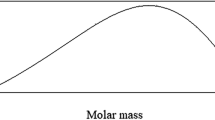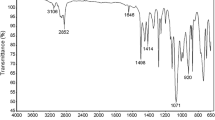Abstract
Diblock copolymers consisting of methylmethacrylate (MMA) and N-hydroxyethylacrylamide (HEAAm) polymer were successfully synthesized via direct two steps atom transfer radical polymerization (ATRP). At first, poly(methylmethacrylate) (PMMA) macroinitiators were prepared using methyl 4-(bromo-methyl) benzoate initiator and were used for synthesizing PMMA-b-PHEAAm block copolymers. PMMA homopolymers were synthesized in N,N′-dimethylformamide (DMF) using CuBr/2, 2′bipyridine catalyst system at 110 °C temperature in nitrogen atmosphere. Block copolymers were synthesized in mixture of DMF/water (8/2 v/v%) and in pure DMF in the presence of CuBr/1,1,4,7,10,10-hexamethyltriethylenetetramine (HMTETA) catalyst system at 85 and 100 °C, respectively, while argon was used for deoxygenation and inert environment. Purification of block copolymers was conducted through dialysis against deionized water using a dialysis tubing (MWCO 3,500, cellulose membrane). Molecular weights of PMMA polymers (M n = 4,400, 6,200 and 8,400 Da) were determined by size exclusion chromatography using tetrahydrofuran (THF) as eluent. The chemical structure and actual copolymer compositions were determined using elemental analysis (EA), attenuated total reflectance infrared (ATR-IR) and proton nuclear magnetic resonance (1H NMR) spectroscopic analysis. Phase separation of diblock copolymers resulting in two glass transition temperatures as detected by differential scanning calorimeter (DSC) proves their amphiphilic behavior. Thermogravimetric analysis (TGA) also showed that diblock copolymer, with two-step decomposition has higher thermal stability than PMMA.





Similar content being viewed by others
References
Riess G (2003) Micellization of block copolymers. Prog Polym Sci 28:1107–1170
Zhao C, Chen Q, Patel K, Li L, Li X, Wang Q, Zhang G, Zheng J (2012) Synthesis and characterization of pH-sensitive poly(N-2-hydroxyethyl acrylamide)–acrylic acid (poly(HEAA/AA)) nanogels with antifouling protection for controlled release. Soft Matter 8:7848–7857
Albarghouthi MN, Buchholz BA, Huiberts PJ, Stein TM, Barron AE (2002) Poly-N-hydroxyethylacrylamide (polyDuramide): a novel, hydrophilic, self-coating polymer matrix for DNA sequencing by capillary electrophoresis. Electrophoresis 23:1429–1440
Hillmyer MA, Bates FS, Almdal K, Mortensen K, Ryan AJ, Fairclough JPA (1996) Complex phase behavior in solvent-free nonionic surfactants. Science 271:976–978
Li S, Davis EN, Huang X, Song B, Peltzman R, Sims DM, Lin Q, Wang Q (2011) Synthesis and development of poly(N-Hydroxyethyl acrylamide)-ran-3- acrylamidophenylboronic acid polymer fluid for potential application in affinity sensing of glucose. J Diabetes Sci Technol 5:1060–1067
Szwarc M (1956) Living polymers. Nature 178:1168–1169
Heish HL, Quirk RP (1996) Anionic polymerization: principles and practical applications. Marcel Dekker, New York
Matyjaszewski K (1996) Cationic polymerizations: mechanisms, synthesis and applications. Marcel Dekker, New York
Novak BM, Risse W, Grubbs RH (1992) The development of well-defined catalysts for ring opening olefin metathesis polymerization (ROMP). Adv Polym Sci 102:47–72
Nagarajan S, Srinivasan KSV (1995) Redox polymerization process: an efficient tool for the synthesis of block copolymers. J Polym Sci Part A Polym Chem 33:2925–2933
Ozturk T, Cakmak I (2007) Synthesis of block copolymers via redox polymerization process: a critical review. Iran Polym J 16:561–581
Matyjaszewski K, Xia J (2001) Atom transfer radical polymerization. Chem Rev 101:2921–2990
Kamigaito M, Ando T, Sawamoto M (2001) Metal-catalyzed living radical polymerization. Chem Rev 101:3689–3746
Hawker CJ, Bosmon AW, Harth E (2001) New polymer synthesis by nitroxide mediated living radical polymerizations. Chem Rev 101:3661–3688
Delaittre G, Save M, Gaborieau M, Castignolles P, Rieger PJ, Charleux B (2012) Synthesis by nitroxide-mediated aqueous dispersion polymerization, characterization, and physical core-crosslinking of pH- and thermoresponsive dynamic diblock copolymer micelles. Polym Chem 3:1526–1538
Hawker CJ (1994) Molecular-weight control by a living free-radical polymerization process. J Am Chem Soc 116:11185–11186
Wayland BB, Poszmik G, Mukerjee SL, Fryd M (1994) Living radical polymerization of acrylates by organocobalt porphyrin complexes. J Am Chem Soc 116:7943–7944
Chiefari J, Chong YK, Ercole F, Krstina J, Jeffery J, Le TPT, Mayadunne RTA, Meijs GF, Moad CL, Moad G, Rizzardo E, Thang SH (1998) Living free-radical polymerization by reversible addition–fragmentation chain transfer: the RAFT process. Macromolecules 31:5559–5562
Kato M, Kamigaito M, Sawamoto M, Higashimura T (1995) Polymerization of methyl methacrylate with the carbon tetrachloride/dichlorotris-(triphenylphosphine)-ruthenium (II)/methylaluminum bis(2,6-di-tert-butylphenoxide) initiating system: possibility of living radical polymerization. Macromolecules 28:1721–1723
Wang JS, Matyjaszewski K (1995) Controlled/“living” radical polymerization, atom transfer radical polymerization in the presence of transition-metal complexes. J Am Chem Soc 117:5614–5615
Zhang X, Matyjaszewski K (1999) Synthesis of well-defined amphiphilic block copolymers with 2-(dimethylamino)ethyl methacrylate by controlled radical polymerization. Macromolecules 32:1763–1766
Kotani Y, Kato M, Kamigaito M, Sawamoto M (1996) Living radical polymerization of alkyl methacrylates and synthesis of their block copolymers. Macromolecules 29:6979–6982
Lee DK, Lee KJ, Kim YW, Kim JH (2008) Synthesis and characterization of crosslinked triblock copolymers for fuel cells. Desalination 233:104–112
Lin W-J, Yi G-B, Wang Q, Su Y-F, Hu W-T, Chen C (2010) The synthesis and characterization of block copolymer PMMA-b-PHEA. J Funct Mater 41:268–271
Ashaduzzaman M, Kai S, Uemura S, Kunitake M (2011) Synthesis and aqueous dispersion properties of triarm poly(NIPAAm-b-HEAAm) diblock copolymers. Chem Lett 40:165–167
Acknowledgments
We are gratefully acknowledged the support from the Graduate School Action Scheme for the Internationalization of University Students (GRASIUS) program of the Ministry of Education, Culture, Sports, Science and Technology of Japan.
Author information
Authors and Affiliations
Corresponding author
Rights and permissions
About this article
Cite this article
Ashaduzzaman, M., Kunitake, M. Poly(methylmethacrylate)-block-poly(N-hydroxyethylacrylamide) diblock copolymers: direct ATRP synthesis and characterization. Iran Polym J 22, 493–499 (2013). https://doi.org/10.1007/s13726-013-0150-6
Received:
Accepted:
Published:
Issue Date:
DOI: https://doi.org/10.1007/s13726-013-0150-6




